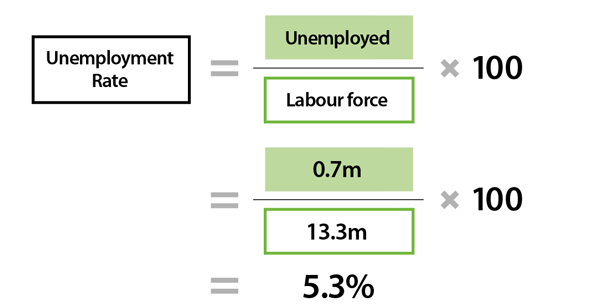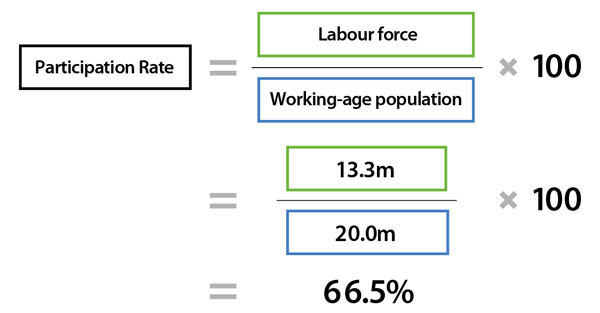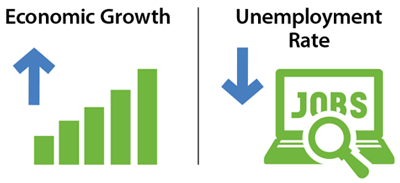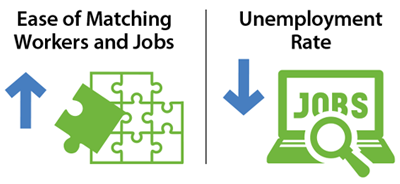Unemployment: Its Measurement and Types
Download the complete Explainer 278KBThe unemployment rate is the most commonly used indicator for understanding conditions in the labour market. The labour market is the term used by economists when talking about the supply of labour (from households) and demand for labour (by businesses and other organisations). The unemployment rate can also provide insights into how the economy is performing more generally, making it an important factor in thinking about monetary policy.
This explainer outlines two key topics related to unemployment.
- How is the unemployment rate measured?
- What are the main types of unemployment?
How is the unemployment rate measured?
Unemployment occurs when someone is willing and able to work but does not have a paid job. The unemployment rate is the percentage of people in the labour force who are unemployed. Consequently, measuring the unemployment rate requires identifying who is in the labour force. The labour force includes people who are either employed or unemployed. Figuring out who is employed or unemployed involves making practical judgements, such as how much paid work someone needs to undertake for them to be considered as having a job, as well as actually counting how many people have jobs or not.

In Australia, the Australian Bureau of Statistics (ABS) is responsible for collecting labour market data. The ABS conducts a survey each month – called the Labour Force Survey – in which it asks around 50,000 people about their participation in the labour market. As part of this survey, the ABS groups people aged 15 years and over (the working-age population) into three broad categories:
- Employed – includes people who are in a paid job for one hour or more in a week.
- Unemployed – includes people who are not in a paid job, but who are actively looking for work.
-
Not in the labour force – includes people not
in a paid job, and who are not looking for work.
This can include people who are studying, caring for children or family members on a voluntary basis, retired, or who are permanently unable to work.
Once the number of people in each of these categories has been estimated, the following labour market indicators can be calculated:
- Labour force – the sum of employed and unemployed people.
- Unemployment rate – the percentage of people in the labour force that are unemployed.
- Participation rate – the percentage of people in the working-age population that are in the labour force.
Box: Calculating the Unemployment Rate – An Example
To understand how the unemployment rate is calculated we can use an example. In this example 12.6 million people are employed and 0.7 million people are unemployed. The size of the labour force is calculated as the sum of these groups.

With the unemployment rate being the percentage of people in the labour force who are unemployed, using the numbers in our example and the equation below, the unemployment rate is calculated as 5.3 per cent.

The unemployment rate is affected by changes in the number of unemployed people (the numerator), which can result from cyclical factors, such as the number of people who become unemployed because of an economic downturn, or more structural factors in the economy (see ‘What are the main types of unemployment?’ below). The unemployment rate is also affected by changes in the size of the labour force (the denominator).
Box: Calculating the Participation Rate – An Example
The participation rate expresses the labour force as a percentage of the working-age population. The working-age population includes Australian residents aged 15 years and over (with some exceptions, such as permanent defence force members).
Using the numbers in the example above there are 13.3 million people in the labour force and, if the working-age population is 20.0 million people, the participation rate is 66.5 per cent.

Labour force participation typically moves with the business cycle. When businesses are hiring more workers and offering higher wages, the incentives are greater to actively look for work. In contrast, when businesses are not hiring and offering smaller wage increases, there is less of an incentive for people to look for work.
There are also structural influences affecting labour force participation that are independent of the business cycle. Some examples of trends that have affected the participation rate in the past include: more opportunities to work part time; an increase in the number of females looking for work (increased female participation); and people working for longer as they delay their retirement.
What are the main types of unemployment?
There are three main types of unemployment – cyclical, structural and frictional unemployment. In practice, these cannot be measured directly, and they can often overlap, but they provide a useful way of thinking about unemployment.
Cyclical Unemployment
Cyclical unemployment occurs with changes in economic activity over the business cycle.
During an economic downturn, a shortfall of demand for goods and services results in a lack of jobs being available for those who want to work. Businesses experiencing weaker demand might reduce the amount of people they employ by laying off existing workers, or hiring fewer new workers. As a result, people looking for work will also find it harder to become employed. The opposite situation occurs when demand strengthens.
Cyclical unemployment is often described as being medium term in nature (one to 12 months). Examples can be seen in the unemployment rate rising sharply with the early 1990s recession, declining to low levels by the mid 2000s before rising again around the time of the global financial crisis.

An increase in cyclical unemployment might suggest the economy is operating below its potential. With more people competing for jobs, businesses might offer lower wage increases, which would contribute to lower inflation. Policies that stimulate aggregate demand, such as expansionary monetary policy, can help reduce this type of unemployment (because businesses experiencing stronger demand are likely to employ more people).
Structural Unemployment
Structural unemployment occurs when there is a mismatch between the jobs that are available and the people looking for work. This mismatch could be because jobseekers don’t have the skills required to do the available jobs, or because the available jobs are a long way from the jobseekers.
Workers may become unemployed if they work in industries that are declining in size or have skills that could be automated as a result of large-scale technological advances. It may be difficult for them to find work in another industry and they may need to develop new skills or move to a region that has more opportunities.
For example, there has been a noticeable decline in the share of people employed in routine manual jobs over recent decades with some of these jobs being automated because of advances in technology. The manufacturing industry is an example of an industry that has a high share of routine manual jobs and its size in the economy has declined (both in terms of production and employment).
Structural unemployment tends to be longer lasting than other types of unemployment. This is because it can take a number of years for workers to develop new skills or move to a different region to find a job that matches their skills. As a result, workers who are unemployed because of structural factors are more likely to face long-term unemployment (for more than 12 months).
In contrast to cyclical unemployment, structural unemployment exists even when economic conditions are good. In theory, this type of unemployment should not directly influence wages or inflation and is best addressed through policies that focus on skills and the supply of labour.
Frictional Unemployment
Frictional unemployment occurs when people move between jobs in the labour market, as well as when people transition into and out of the labour force.
Movement of workers is neccessary for a flexible labour market and helps achieve an efficient allocation of labour across the economy. However, people may not find jobs immediately and need to invest time and effort in searching for the right job. Businesses also spend time searching for suitable candidates to fill job vacancies. As a result, people looking for jobs are not matched immediately with vacancies and may experience a period of temporary unemployment.
This type of unemployment is generally shorter term (less than one month). Frictional unemployment is likely to occur at all points of the business cycle and, like structural unemployment, may not influence wages or inflation.

These three types of unemployment are not independent of each other. For example, a period of high cyclical unemployment might lift structural unemployment. This could occur when people are unemployed for such a long period that their skills and productivity deteriorate, and they become seen as being less employable, reducing the probability that they will be hired in the future.
Other Types of Unemployment
There are some other types of unemployment that are also important to consider. In particular, the underemployment rate can be thought of as a complementary indicator to the unemployment rate when thinking about conditions in the labour market.
- Underemployment occurs when people are employed, but would like and are available to work more hours. There are two categories of underemployed people defined by the ABS. First, part-time workers who would prefer to work additional hours. Second, people who usually work full time, but are currently working part-time hours. Underemployment rates are generally higher among groups that have a larger proportion of people working part time, such as females, younger workers and older workers.
- Hidden unemployment occurs when people are not counted as unemployed in the formal ABS labour market statistics, but would probably work if they had the chance. For example, someone might have looked for work for a long time, given up hope and stopped looking, but still wish to work. (These people are sometimes referred to as ‘discouraged workers’.)
- Seasonal unemployment occurs at different points over the year because of seasonal patterns that affect jobs. Some examples include ski instructors, fruit pickers and holiday-related jobs. The ABS publishes seasonally adjusted labour market statistics, which remove seasonal patterns in the data.